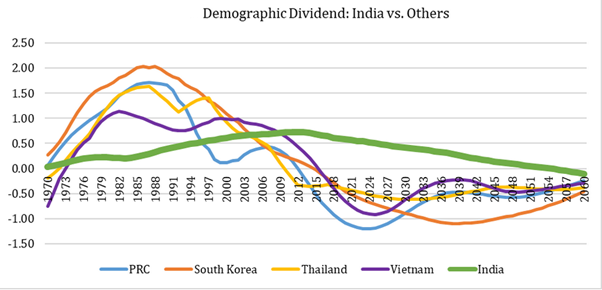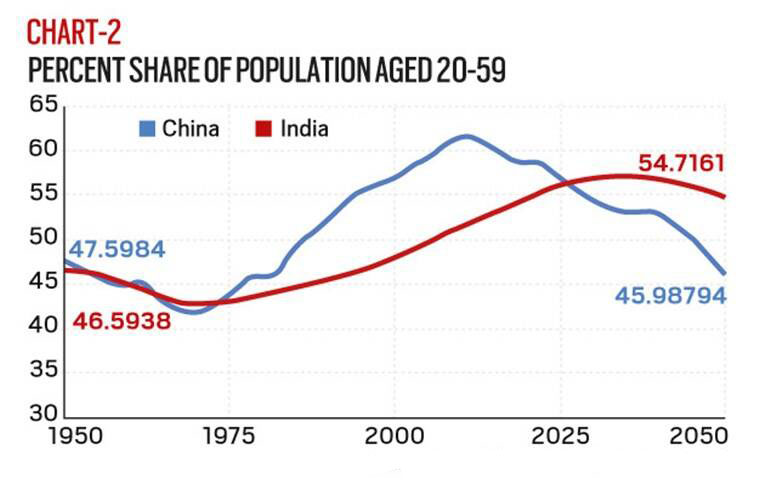Social Issues
A Multifaceted Approach to Population Management
- 09 Feb 2024
- 14 min read
This editorial is based on “Charting a path for the population committee” which was published in The Hindu on 09/02/2024. The article explains that the announcement in the Interim Budget 2024-25 of a “high-powered committee, also called Population Committee, to extensively consider the challenges arising from rapid population growth and demographic changes” is groundbreaking and needs to adopt an interdisciplinary approach in its operation.
For Prelims: India’s demographic dividend, UN World Population Prospects (WPP) 2023, National Family Health Survey, Total Fertility Rate (TFR), Human Development Index, NSSO Periodic Labour Force Survey
For Mains: Demographic Changes of India, Significance of Population Growth, Reaping the Demographic Dividend - Bottlenecks and Way Ahead.
According to the latest projections by the United Nations (UN), India’s population is expected to reach 1.46 billion by 2030, comprising 17% of the world’s projected population. While India experienced a phenomenal population growth until the 1970s, growth rates have slowed since then, with fertility levels in steady decline.
This decline, which is reflected in the Total Fertility Rate (TFR), has been instrumental in shaping India’s demographic trajectory. With the TFR projected to touch 1.73 in 2031-35 from 2.5 in 2009-11, India will witness a demographic transition characterised by a decreasing proportion of the child population and an increasing proportion of the working-age population.
What are the Present Population Growth Trends in India?
- Decline in Population Growth:
- Percentage decadal growth rate of population has been declining since 1971-81 at all India levels.
- However, significant fall in case of EAG States (Empowered action group states: UP, Uttarakhand, Bihar, Jharkhand, MP, Chhattisgarh, Rajasthan and Orissa) was noticed for the first time during the 2011 census.
- Decline in India’s TFR:
- The TFR has further declined from 2.2 to 2.0 at the national level between National Family Health Surveys (NFHSs) 4 and 5.
- There are only five states in India which are above replacement level of fertility of 2.1. These states are Bihar, Meghalaya, Uttar Pradesh, Jharkhand and Manipur.
- Replacement level fertility is the total fertility rate, the average number of children born per woman at which a population exactly replaces itself from one generation to the next, without migration.
- Improvement in Mortality Indicators:
- Life expectancy at birth saw a remarkable recovery from 32 years in 1947 to 70 years in 2019.
- According to NFHS-5, Infant Mortality Rate (IMR) stands at 32 per 1,000 live births which includes an average 36 deaths for rural and 23 for urban areas.
- Increase in Family Planning:
- According to NFHS-5, overall Contraceptive Prevalence Rate (CPR) has increased substantially from 54% to 67% at all-India level and in almost all Phase-II States/UTs with the exception of Punjab.
- Improvement in Life Expectancy:
- As per the recent United Nations Population Fund (UNFPA) report ‘State of World Population report 2023’:
- The average life expectancy for an Indian male was projected as 71 and 74 for females.
- For developed regions, the average life expectancy for males was projected at 77 and 83 for females-the highest of all.
- For less developed regions, the ages are 70 for males and 74 for females, while for least developed countries, it is 63 for males and 68 for females.
- As per the recent United Nations Population Fund (UNFPA) report ‘State of World Population report 2023’:
- Robust Demographic Dividend:
- India's population offers a significant advantage in terms of a large workforce, which can help drive economic growth.
- India’s 68% population are in the 15 to 64 years age group, providing a significant contribution to the working or able-to-work population.
- India has one of the youngest populations in an ageing world. By 2022, the median age in India was just 29, compared to 38 in China and the US, 46 in Western Europe, and 51 in Japan.
What was the Need for Formation of the Population Committee in India?
- Large Projected Population:
- As per the UN estimates, India's population will surpass 1.5 billion people by the end of this decade and will continue to slowly increase until 2064, when it will peak at 1.7 billion people.
- Despite a slowdown in population growth rates, demographic transitions are underway, with implications for India's age distribution and economic growth potential.
- Harnessing Demographic Dividend and Economic Growth:
- India's demographic dividend presents an opportunity for accelerated economic growth per capita, provided investments are made in health, education, and skill development.
- Capitalising on this dividend requires initiatives to enhance human capital and integrate marginalised groups into the workforce which the envisaged committee can complement significantly.
- Addressing Challenges in Health, Education, and Employment:
- Public spending on health has remained around 1% of GDP, underscoring the need for policies that prioritise health promotion and allocate greater finances to health infrastructure.
- According to UNICEF, nearly 47% of Indian youth may lack the necessary education and skills for employment by 2030.
- The disruptions caused by the COVID-19 pandemic have exacerbated these challenges, with over 250 million children forced out of school, causing significant setbacks in learning outcomes.
- The Population Committee will help enhance the targeted approach to these segments in a streamlined and comprehensive manner.
- Public spending on health has remained around 1% of GDP, underscoring the need for policies that prioritise health promotion and allocate greater finances to health infrastructure.
- Importance of Evidence-Based Decision Making:
- Accurate and timely data are essential for evidence-based policymaking. India faces challenges in statistics availability and quality, necessitating improvements in estimate collection methodologies, technology adoption, and collaboration with stakeholders.
- The high-powered committee can offer a viable alternative to lagging data provided by National Sample Survey Organisation (NSSO) and NFHS.
- Need for Modernising Data Infrastructure:
- Modernising data infrastructure through digital technologies and robust systems is crucial for accurate demographic data collection and analysis.
- Investments in data collection methods, data processing technologies, and data security are imperative for reliable population statistics.
- Realising Inclusive and Sustainable Development:
- By adopting a holistic approach to population management, prioritising investments in health, education, employment, and statistical systems, India can realise its growth potential and achieve inclusive and sustainable development.
- Strategic planning, effective implementation, and international collaboration are key to navigating India's transition successfully, to be done successfully on the plank of the proposed population committee.
What are the Different Points to be Incorporated in the Formation of the Population Committee?
- Adopting a Multi-Sectoral Strategy:
- The Interim Budget’s introduction of this significant initiative must align with the goal of 'Viksit Bharat'. This committee should adopt a multi-sectoral strategy encompassing various domains such as family planning, maternal and child health, education, employment, and socio-economic development such as :
- Designing play-based flexible curricula, and engaging parents, communities, and stakeholders to generate demand for early childhood education are other measures to improve outcomes.
- Additionally, efforts to bridge the gap between existing skill development initiatives and industry requirements are essential to reduce unemployment and increase productivity.
- The Interim Budget’s introduction of this significant initiative must align with the goal of 'Viksit Bharat'. This committee should adopt a multi-sectoral strategy encompassing various domains such as family planning, maternal and child health, education, employment, and socio-economic development such as :
- Interdisciplinary Approach to Population Management:
- The success of the population committee relies on its interdisciplinary approach, drawing expertise from demography, public health, economics, sociology, and governance.
- By leveraging diverse perspectives, the committee should identify emerging issues and assess the efficacy of existing interventions through rigorous research and data analysis.
- The success of the population committee relies on its interdisciplinary approach, drawing expertise from demography, public health, economics, sociology, and governance.
- Synergistic Efforts for Effective Implementation:
- Collaboration with diverse stakeholders including governmental agencies, NGOs, civil society, academia, and the private sector is essential for effective policy implementation at both national and grassroots levels.
- These partnerships will foster collective action and ensure the success of population-related programs.
- Emphasis on Public Awareness and Education:
- Apart from policy formulation, the committee must emphasise public awareness and education campaigns. By empowering individuals and communities with accurate information, it aims to promote responsible family planning practices and enhance health outcomes.
- International Collaboration in Population Management:
- Facilitating international collaboration and the exchange of best practices in population management is crucial. Learning from global experiences and collaborating with international organisations can enrich India's strategies in addressing demographic challenges.
- Collaboration with international organisations such as the United Nations Population Division, World Bank, and academic institutions can provide access to global best practices, technical expertise, and funding opportunities for population data collection and analysis.
- Facilitating international collaboration and the exchange of best practices in population management is crucial. Learning from global experiences and collaborating with international organisations can enrich India's strategies in addressing demographic challenges.
- Integrating India's Evolving Demographic Landscape:
- India's demographic landscape has witnessed significant shifts over the years, marked by declining fertility rates, an increasing working-age population, and a rising elderly population.
- Understanding these changes through the stipulated committee is critical for shaping future economic and demographic trajectories.
- India's demographic landscape has witnessed significant shifts over the years, marked by declining fertility rates, an increasing working-age population, and a rising elderly population.
- Adopting Quality Assurance Mechanisms for Data Reliability:
- Implementing rigorous validation and quality assurance mechanisms ensures the reliability and accuracy of population data. Independent audits, data validation exercises, and peer review processes will play a vital role in identifying and rectifying data errors.
- Facilitating Data Accessibility to Researchers:
- Promoting open data initiatives and transparency in data sharing enhances access to population data for researchers, policymakers, and the public.
- Committee should promote standardised formats and data sharing protocols to facilitate data reuse, transparency, and accountability in the research process.
Conclusion
The establishment of a high-powered committee to address the challenges posed by rapid population growth and demographic changes marks a significant step towards formulating effective policies and strategies. This committee must adopt an interdisciplinary approach, collaborate with stakeholders, and focus on public awareness and education campaigns to manage population growth effectively. India's demographic landscape presents both opportunities and challenges, with the potential for accelerated economic growth if investments are made in health, education, and employment.
|
Drishti Mains Question: Discuss the role of a high-powered population committee in harnessing India's demographic dividend for inclusive and sustainable development. |
UPSC Civil Services Examination, Previous Year Questions (PYQs)
Prelims
Q. In the context of any country, which one of the following would be considered as part of its social capital? (2019)
(a) The proportion of literates in the population
(b) The stock of its buildings, other infrastructure and machines
(c) The size of population in the working age group
(d) The level of mutual trust and harmony in the society
Ans: (d)
Q. India is regarded as a country with “Demographic Dividend”. This is due to (2011)
(a) Its high population in the age group below 15 years
(b) Its high population in the age group of 15-64 year
(c) Its high population in the age group above 65 years
(d) Its high total population
Ans: (b)
Mains
Q. Discuss the main objectives of Population Education and point out the measures to achieve them in India in detail. (2021)
Q. “Empowering women is the key to control the population growth.’’ Discuss. (2019)
Q. Critically examine whether growing population is the cause of poverty or poverty is the main cause of population increase in India. (2015)









